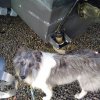Chasin' Dreams
Well-Known Member
I've got a Lowrance Gen 2 HDS 12 touch screen at my helm that is tied into my NMEA 2000 backbone with the AIS, Radar etc all on the same backbone. I want to put a second 9" or 12" sonar plotter at my rear helm and have a couple questions about doing so. Wondering if any of you guys have experience with doing so or certain brands models that you like over the others?
When I add the second unit I would like to have it on it's own, separate from the front helm unit. Like not sharing the same screen as the other unit. So I realize this would mean having the second unit on it's own transducer but will I be able to simply add this unit into the NMEA backbone and then just put it on it's own power source/fuse? Or is there more to it than that? My backbone has it's own power input to the backbone so I should just be able to put another "T" into the backbone for the second sounder/plotter right?
I've had the Lowrance HDS touch screens on my last couple boats and am used to their functions. If I go with a different brand/model for the rear unit such as a Simrad do you think there's a lot of difference to get used to with their functions/options? I was told that Simrad is the parent company of Lowrance so do they have similar funtions?
Side scan abilities... My forward helm Lowrance unit has the ability to have a side scan transducer put on it but I don't have that on it yet but have been thinking about it. A sales guy at a store the other day told me that some of the new 12" units available right now come with the side scanning transducers. I haven't confirmed which units he was referring to yet but am interested in the side scan if it is very beneficial to bottom fishing and salmon fishing. Any of you guys use the side scanning transducers? What are your opinions on this feature? Worth it as an add on or if the new units come with it?
I think most of the new units these days also come with wifi updating capabilities but if there are any other functions and abilities that certain brands/models have that others don't please include that info too.
When I add the second unit I would like to have it on it's own, separate from the front helm unit. Like not sharing the same screen as the other unit. So I realize this would mean having the second unit on it's own transducer but will I be able to simply add this unit into the NMEA backbone and then just put it on it's own power source/fuse? Or is there more to it than that? My backbone has it's own power input to the backbone so I should just be able to put another "T" into the backbone for the second sounder/plotter right?
I've had the Lowrance HDS touch screens on my last couple boats and am used to their functions. If I go with a different brand/model for the rear unit such as a Simrad do you think there's a lot of difference to get used to with their functions/options? I was told that Simrad is the parent company of Lowrance so do they have similar funtions?
Side scan abilities... My forward helm Lowrance unit has the ability to have a side scan transducer put on it but I don't have that on it yet but have been thinking about it. A sales guy at a store the other day told me that some of the new 12" units available right now come with the side scanning transducers. I haven't confirmed which units he was referring to yet but am interested in the side scan if it is very beneficial to bottom fishing and salmon fishing. Any of you guys use the side scanning transducers? What are your opinions on this feature? Worth it as an add on or if the new units come with it?
I think most of the new units these days also come with wifi updating capabilities but if there are any other functions and abilities that certain brands/models have that others don't please include that info too.





